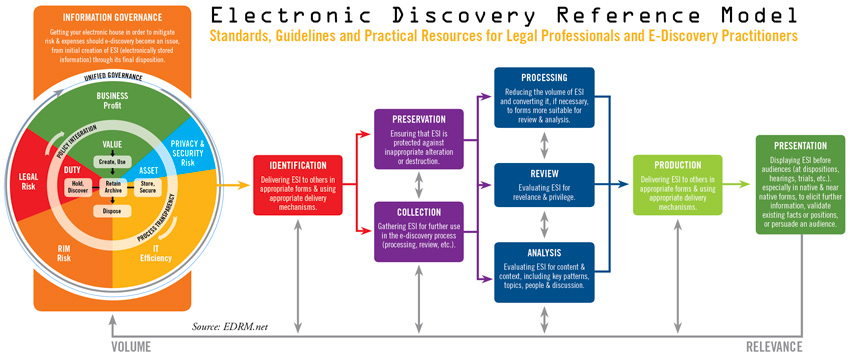e-Discovery 101
Electronic Discovery or eDiscovery is the term used for the initial phase of litigation where the parties in a dispute are required to provide each other relevant information and records, along with all other evidence related to the case (AIIM).
While discovery is not an old term, eDiscovery became a hot topic in the mid-2000s when Electronically Stored Information (ESI) was referenced in the Federal Rules of Civil Procedure (FRCP) in the 2006 amendments. The FRCP were amended again in 2015 where eDiscovery was the driving factor in this amendment:
“The burden or expense of proposed discovery should be determined in a realistic way. This includes the burden or expense of producing electronically stored information. Computer-based methods of searching such information continue to develop, particularly for cases involving large volumes of electronically stored information. Courts and parties should be willing to consider the opportunities for reducing the burden or expense of discovery as reliable means of searching electronically stored information become available“ (Abovelaw.com).
Additional amendments were made to ensure the costs or acquiring and searching ESI were proportional to the amount of damages the litigation contemplated. Also, to ensure preservation and the avoidance of spoliation, which is the adulteration or possible adulteration of evidence. Further, the committee notes in the FCRP provide guidance on how to handle the newly amended rule.
“Due to the ever-increasing volume of electronically stored information and the multitude of devices that generate such information, perfection in preserving all relevant electronically stored information is often impossible…This rule recognizes that ‘reasonable steps’ to preserve suffice; it does not call for perfection. The court should be sensitive to the party’s sophistication with regard to litigation in evaluating preservation efforts; some litigants, particularly individual litigants, may be less familiar with preservation obligations than others who have considerable experience in litigation” (Abovelaw.com).
Why does any of this matter?
If you are reading this article, you’re new to discovery, the law, or just want a basic understanding of eDiscovery. Discovery is about evidence and building a case. The weight of the evidence—the dynamic whereby the fact finder compares information to determine what fits in his mental construct, and what is rejected, and thus falls away (Foundations of Digital Evidence by George Paul). George Paul goes on to explain how authenticity, integrity, time, identity, hearsay, and reliability provide the crucial foundation of building a case with ESI.
Now that we have the rules, where do we find this information?
“The average employee creates roughly one gigabyte of data annually (and growing), and data volumes are expected to increase over the next decade…as much as 50 times what it is today” (in Robert Smallwood’s Information Governance: Concepts, Strategies, and Best Practices (Wiley, 2014). Smallwood goes on to reference a landmark eDiscovery Case—Zubulake v. UBS Warburg:
A landmark case in e-discovery arose from the opinions rendered in Zubulake v. U.B.S. Warburg, an employment discrimination case where the plaintiff, Laura Zubulake, sought access to e-mail messages involving or naming her. Although UBS produced over 100 pages of evidence, it was shown that employees intentionally deleted some relevant e-mail messages. The plaintiffs requested copies of e-mail from backup tapes, and the defendants refused to provide them, claiming it would be too expensive and burdensome to do so.
The judge ruled that UBS had not taken proper care in preserving the e-mail evidence, and the judge ordered an adverse inference (assumption that the evidence was damaging) instruction against UBS. Ultimately, the jury awarded Zubulake over $29 million in total compensatory and punitive damages. “The court looked at the proportionality test of Rule 26(b)(2) of the Federal Rules of Civil Procedure and applied it to the electronic communication at issue. Any electronic data that is as accessible as other documentation should have traditional discovery rules applied.” Although Zubulake’s award was later overturned on appeal, it is clear the stakes are huge in e-discovery and preservation of ESI.
The EDRM Model provides further insight on how to handle eDiscovery and has broken eDiscovery into the stages below:
Information Governance – Getting your electronic house in order to mitigate risk & expenses should e-discovery become an issue, from initial creation of ESI (electronically stored information) through its final disposition.
Identification – Locating potential sources of ESI & determining its scope, breadth & depth.
Preservation – Ensuring that ESI is protected against inappropriate alteration or destruction.
Collection – Gathering ESI for further use in the e-discovery process (processing, review, etc.).
Processing – Reducing the volume of ESI and converting it, if necessary, to forms more suitable for review & analysis.
Review – Evaluating ESI for relevance & privilege.
Analysis – Evaluating ESI for content & context, including key patterns, topics, people & discussion.
Production – Delivering ESI to others in appropriate forms & using appropriate delivery mechanisms.
Presentation – Displaying ESI before audiences (at depositions, hearings, trials, etc.), especially in native & near-native forms, to elicit further information, validate existing facts or positions, or persuade an audience.
EDiscovery and the changes to the FRCP in 2006, and again in 2015, laid the foundation and further clarified how ESI can be used for cases in the 21st century. Additionally, the eDiscovery frameworks and EDRM provide excellent guidance on what to keep and what not to keep regarding information.
If you want specifics on how discovery and disposition are handled at the US federal level, read the FRCP and consider this snippet from US Legal.
Rules 26 to 37 of Title V of the Federal Rules of Civil Procedure (FRCP) deal with depositions and discovery. These rules guide the discovery process at the federal level. Most of the state courts have a similar version of the Federal Rules. A summary of rules 26 to 37 under chapter V is given here.
recent posts
You may already have a formal Data Governance program in [...]

